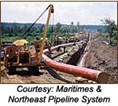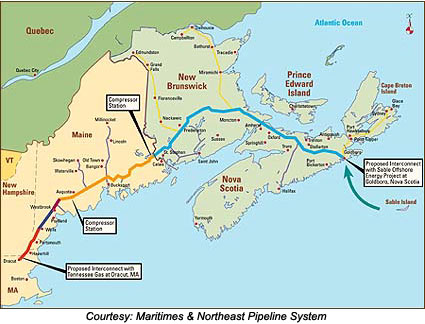Nova Scotia gets natural gas

By C. Stevenson, Halifax, Nova Scotia
History was made in Atlantic Canada when Maritimes & Northeast Pipeline (M&NP) delivered natural gas to Nova Scotia Power's Tufts Cove generating station, Nov. 1, 2000. Tufts Cove is the cornerstone of M&NP's Nova Scotia lateral pipeline system that will deliver Sable Offshore Energy Inc. natural gas to industrial customers throughout the province. M&NP has been delivering Sable gas to US markets since Dec. 31, 1999, but Tufts Cove marks the first delivery to a customer on this side of the border.
Nova Scotia Power provides 97% of the province's energy needs, 90% of which is produced from five thermal generating plants. The Tufts Cove plant was previously dependant on oil, and Nova Scotia Power spent approximately C$24 million modifying generating units and installing state-of-the-art control systems in preparation for natural gas. With three generating units, the facility has the capacity to produce 350 megawatts and use 61.6 billion Btu of natural gas, per day. Tufts Cove has the ability to fuel switch between oil and natural gas, allowing flexibility of the fuel mix and ensuring a competitive edge as market prices for the two commodities fluctuate. This daily Btu delivery to Nova Scotia is expected to increase significantly once the Nova Scotia lateral distribution system is completed by Sempra Atlantic Gas, and private consumers have direct access to natural gas.
 Nova Scotia's gas distribution policy has come under fire and was publicly criticized when SaskEnergy withdrew its bid to build the province's gas distribution system. Company President and CEO, Ronald S. Clark declared the economics of the project to be "fundamentally impacted" by the policy that encourages industrial customers, like Tufts Cove, to bypass the distribution system. In spite of this concern there were still contenders for the distribution franchise and Sempra was awarded the contract in Dec., 1999.
Nova Scotia's gas distribution policy has come under fire and was publicly criticized when SaskEnergy withdrew its bid to build the province's gas distribution system. Company President and CEO, Ronald S. Clark declared the economics of the project to be "fundamentally impacted" by the policy that encourages industrial customers, like Tufts Cove, to bypass the distribution system. In spite of this concern there were still contenders for the distribution franchise and Sempra was awarded the contract in Dec., 1999.
"The company plans to build a network of 4,800 miles of steel and plastic pipe to reach 78% of households across the province," says Sempra spokesperson Lori MacLean. The entire $1 billion endeavor will take approximately seven years to complete. Construction began on Oct. 9, 2000, only two days after final permits were granted. Crews have installed approximately 10 miles of pipe within the city. "It's a good start," says Halifax construction manager Bernard Perron. The plan now depends on M&NP building tap stations for Sempra, that will allow gas to flow from M&NP's lateral pipelines into Sempra's distribution system. Documents are currently before the National Energy Board (NEB) for the construction of the transfer stations. "Without the tap stations in place, it is unlikely that natural gas will be available until the spring of 2001 to customers in N.S.," says MacLean, "though parties are trying to speed up the process, where possible."
Permits and regulatory procedures are time consuming and the NEB is not the only organization M&NP and Sempra have to deal with. Bureaucracy at all three levels of government and numerous independent agencies, each with its own agenda, add to the mix. Sempra is currently awaiting approval from the Provincial Department of Transportation to lay high pressure lateral pipeline along secondary road shoulders. The proposal is being reviewed by a panel of experts with the Transportation Association of Canada and a decision is not expected until Feb., 2001.

During construction of the mainline through both Nova Scotia and New Brunswick, M&NP hurdled a series "glitches", but nothing uncommon in the industry. Land acquisition and environmental issues were reported and the original route was altered to accommodate wildlife species, including a four-toed salamander, and fish habitats.
The only significant problem was encountered when M&NP's lateral between the refinery in Goldboro and Point Tupper, on Cape Breton Island, failed a pressure test. The situation was corrected and on Aug. 10, 2000, the NEB granted M&NP Leave to Open the Point Tupper Lateral. However, the Leave to Open specified a maximum operating pressure of 4710 kPa - approximately 50% of the originally applied for total. On Sept. 29, 2000 M&NP responded by submitting an application to the NEB to construct a pressure reducing facility to limit the pressure in the lateral to a maximum of 4710 kPa. The company had originally anticipated an in-service date of November 1999, for the Point Tupper lateral.
In New Brunswick, M&NP has already received approval from the NEB for facilities including tap stations, to serve lateral's contractor Enbridge Gas New Brunswick, in Moncton, St. George, and Fredericton. Three of four proposed tap stations for Saint John have also been approved.
 The M&NP pipeline system consists of an approximately 650 miles of underground mainline pipeline running from Goldboro, Nova Scotia through New Brunswick to the Canadian-US border near Baileyville, Maine. The pipeline continues through Maine and New Hampshire into Massachusetts where it connects with the existing North American pipeline grid at Dracut, Massachusetts.
The M&NP pipeline system consists of an approximately 650 miles of underground mainline pipeline running from Goldboro, Nova Scotia through New Brunswick to the Canadian-US border near Baileyville, Maine. The pipeline continues through Maine and New Hampshire into Massachusetts where it connects with the existing North American pipeline grid at Dracut, Massachusetts.
M&NP's delivery of Sable gas to US markets last year was the first time in more than two decades that a major new natural gas supply basin was brought to market in North America. M&NP provides up to 530 billion Btu per day to markets in Atlantic Canada and the northeastern United States.
Owned by Duke Energy, M&NP Management Company is responsible for the overall development of the M&NP pipeline and directly responsible for the operation of the US system. Project affiliates include Westcoast Energy Inc., Exxon Mobil Corporation, and NS Power Holdings Inc.
Sempra Atlantic Gas is a unit of Sempra Energy International (SEI), which owns, develops and operates a variety of energy projects. SEI is a subsidiary of Sempra Energy, a Fortune 500 services holding company based in San Diego.
